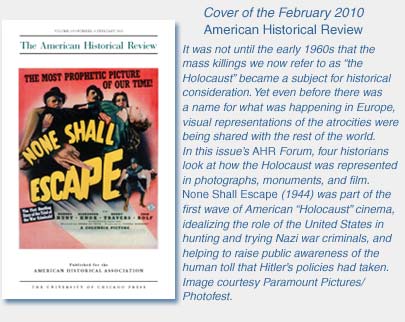 The February 2010 issue of the American Historical Review should soon be in members’ mailboxes and also online from the University of Chicago Press. As usual in February each year, it contains the Presidential Address, as well as an AHR Forum on “Representing the Holocaust” and an AHR Exchange on “The Question of ‘Black Rice.’” In addition, there are five featured reviews, followed by our usual extensive book review section. One distinctive feature of this issue is its visual richness: it includes more than 60 illustrations.
The February 2010 issue of the American Historical Review should soon be in members’ mailboxes and also online from the University of Chicago Press. As usual in February each year, it contains the Presidential Address, as well as an AHR Forum on “Representing the Holocaust” and an AHR Exchange on “The Question of ‘Black Rice.’” In addition, there are five featured reviews, followed by our usual extensive book review section. One distinctive feature of this issue is its visual richness: it includes more than 60 illustrations.
The Presidential Address, “An American Album, 1857,” by Laurel Thatcher Ulrich, is a meditation on the history and meaning of one particular quilt made in the Territory of Utah by a group of female members of the Church of Latter-day Saints. The quilt survives today, and Ulrich is able to use it as an artifact of history in order to examine, among other things, conflicts over marriage in the United States in the nineteenth century. While providing a micro-history of the provenance of the quilt, including information on some of the 67 women who stitched their names into its fabric, her story takes us deep into the history of frontier life; the struggles between Mormons and the federal government; marriage, sexuality, gender roles, and religion; Indian-Mormon relationships; immigration; and, ultimately, the “aspirations and contradictions embedded in the history of the American republic.”
The AHR Forum, “Representing the Holocaust,” comprises three articles plus a comment. The articles look at three different forms of visual representation in the years after, and in the first case during, the period of the destruction of European Jewry. A series of photographs taken by Russian Jewish photojournalists in 1942 is the focus of “Picturing Grief: Soviet Holocaust Photography at the Intersection of History and Memory,” by David Shneer, who uses these illustrations to analyze the Soviet Union’s contradictory and often fraught treatment of the mass murder of the Jews. Harold Marcuse turns to the aesthetic and political meanings of monuments in “Holocaust Memorials: The Emergence of a Genre.” Analyzing a whole series of these physical commemorations of the Judeocide, dating from the immediate aftermath of the liberation of the death and concentration camps to more recent decades, he argues that the evolution of the aesthetics of these displays reveals important changes in our appreciation of the Holocaust and its various meanings. The third article, “The First Wave of American ‘Holocaust’ Films, 1945–1959,” by Lawrence Baron, focuses on early movies that, sometimes obliquely, sometimes more directly, evoked the Holocaust while largely leaving the Jewish identity of its victims unacknowledged. Sarah Farmer’s comment on the three essays, “Going Visual: Holocaust Representation and Historical Method,” not only offers some critical suggestions about their findings and approaches but also reflects on how we should asses and use visual evidence in our historical accounts.
History thrives through controversy, and in the AHR Exchange we open our pages to three critiques of an article that we published in the 2007 issue. “Agency and Diaspora in Atlantic History: Reassessing the African Contribution to Rice Cultivation in the Americas,” by David Eltis, Philip Morgan, and David Richardson, has clearly challenged some established views on the subject of “black rice.” The three comments—“Beyond ‘Black Rice’: Reconstructing Material and Cultural Contexts for Early Plantation Agriculture,” by S. Max Edelson; “Africa and Africans in the African Diaspora: The Uses of Relational Databases,” by Gwendolyn Midlo Hall; and “From ‘Black Rice’ to ‘Brown’: Rethinking the History of Risiculture in the Seventeenth- and Eighteenth-Century Atlantic,” by Walter Hawthorne—not only criticize the original article but also offer analytical and methodological alternatives. In their response, Eltis, Morgan, and Richardson defend their findings against these critiques and conclude that despite their skepticism regarding the African origin of risiculture in the Americas, this is not meant to deny the role of African agency in this historical context.
The April issue of the AHR will include an article by Lyndal Roper titled “Martin Luther’s Body,” and an AHR Forum on “East Meets West in South Asia.”
Robert Schneider (Indiana Univ.) is the editor of the AHR.
Tags: AHA Activities Scholarly Communication
Comment
Please read our commenting and letters policy before submitting.






